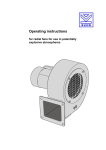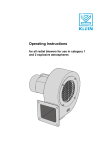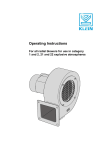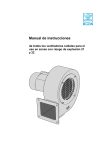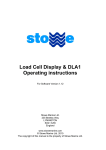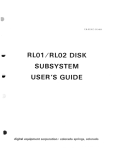Download Operating instructions - Karl Klein Ventilatorenbau GmbH
Transcript
Operating instructions for mobile radial fans designated for use with potentially explosive atmospheres according to zones 1, 2 and 22 Operating instructions for radial fans designated for operation with potentially explosive atmospheres Printed in Germany We reserve the right to make changes via technical development compared with the details and illustrations in these operating instructions. Reproduction, translation and copying in any form – even in part – subject to written approval from the manufacturer. These operating instructions will not be subject to any change service. Please contact the manufacturer for the current status. KARL KLEIN Ventilatorenbau GmbH 24 Waldstrasse 73773 Aichwald Phone.: 07 11 - 36 90 6-0 Fax.: 07 11 - 36 90 6-50 Internet: www.karl-klein.de e-mail: [email protected] Status: 04/2014 04/2014 KARL KLEIN Ventilatorenbau GmbH Page 1 Operating instructions for radial fans designated for operation with potentially explosive atmospheres Contents 1 1.1 1.2 1.3 1.4 1.5 1.6 1.7 Preliminary notes .............................................................................................................. 3 Notes from the manufacturer to the operator ..................................................................... 3 The tasks of fan operators in potentially explosive atmospheres ....................................... 5 Warranty ............................................................................................................................. 6 Symbols used ..................................................................................................................... 7 Product-related laws, conditions and regulations ............................................................... 8 National accident prevention regulations and conditions ................................................... 8 Name and instruction plates ............................................................................................... 9 2 2.1 2.2 Proper use ......................................................................................................................... 10 Limits of use and features of proper use ............................................................................ 10 Improper use ....................................................................................................................... 11 3 3.1 3.2 3.2.1 3.2.2 3.2.3 3.3 3.4 Safety ................................................................................................................................. 12 Basic safety information...................................................................................................... 12 Emissions ........................................................................................................................... 14 Dust, gases and vapours .................................................................................................... 14 Noise ................................................................................................................................... 14 Vibrations ............................................................................................................................ 14 Overheating/ambient conditions ......................................................................................... 14 Transport and storage ........................................................................................................ 15 4 General function description ........................................................................................... 16 5 5.1 5.2 5.3 5.4 Setting up/connection/commissioning/operation ......................................................... 17 General safety instructions ................................................................................................. 17 Setting up, connecting and installing .................................................................................. 18 Assembly and installation instructions for potentially explosive atmospheres ................... 18 Fan connection ................................................................................................................... 19 6 6.1 6.2 6.3 6.4 6.5 Information on maintenance, care and repair ............................................................... 20 Maintenance and care ........................................................................................................ 20 Check bearings ................................................................................................................... 20 Maintain the supporting frames and chassis in working order ........................................... 20 Repair notes and procedures ............................................................................................. 21 Contamination in case of repair returns.............................................................................. 21 7 Disposal ............................................................................................................................. 21 04/2014 KARL KLEIN Ventilatorenbau GmbH Page 2 Operating instructions for radial fans designated for operation with potentially explosive atmospheres 1 Preliminary notes 1.1 Notes from the manufacturer to the operator Please follow the safety instructions. Please read carefully all safety instructions in these operating instructions. Familiarize yourself with the handling of the fan before starting work. It will be too late to do so once you are working. Do not allow anyone without the specialist knowledge to turn on and use this fan. Validity These operating instructions apply to all mobile ATEX fans with the following descriptions: MRV-DNG 3-6, -DNG 3-9.8, -DNG 4-14, -DNG 5-12.5, -DNG 5-16, -DNG 5-19 … II 2G c IIB T3, T4 or II 3G c IIB T3, T4 or II 3D c T 125° C MRV-DNG 9-30, -DNG 9-43, -DNG 10-45, -DNG 10-65 … II 2G c IIB T3 or II 3G c IIB T3 or II 3D c T 125° C MRV-DMVL 345-1-12, -DMVL 355-1-25, -DMVL 315-1-60, -DMVL 375-1-35 … II 2G c IIB T3 or II 3G c IIB T3 or II 3D c T 125° C 04/2014 KARL KLEIN Ventilatorenbau GmbH Page 3 Operating instructions for radial fans designated for operation with potentially explosive atmospheres Purpose of these operating instructions These operating instructions will be provided with the scope of delivery. They also serve as assembly instructions. The manufacturer drew up these operating instructions based on its knowledge and experience in construction, manufacturing and operation. They can be complemented by special instructions by the operator (e.g., for supervision and obligatory registration, in-house maintenance and servicing schedules). Symbolic illustration in these operating instructions The graphic illustrations and drawings represent the main view of a fan. They are not to scale neither do they show the proportions of each fan from the delivery range. The illustrations are only intended as a guide. The detailed dimensions and views are listed in the catalogue and available from the manufacturer. Copyright The copyright to these instructions remain with KARL KLEIN Ventilatorenbau GmbH. The operating instructions may not be reproduced or made available to unauthorized third parties or persons in part or in whole without prior approval from KARL KLEIN Ventilatorenbau GmbH. You as the operator will be responsible for the fan only being used by trained specialist personnel, adherence to the safety regulations and safety instructions and the health and safety at work precautions, the technical training of the operating personnel and their familiarization with the operating instructions. 04/2014 KARL KLEIN Ventilatorenbau GmbH Page 4 Operating instructions for radial fans designated for operation with potentially explosive atmospheres 1.2 The tasks of fan operators in potentially explosive atmospheres What are essential here are the European Directive 94/9, and national prescriptions equal to the German Industrial Safety Ordinance (BetrSichV), the Equipment and Product Safety Act (GPSG) and the 11th Ordinance on the Equipment and Product Safety Act (11th GPSGV Explosion Prevention Ordinance). They impose certain measures on equipment operators for their use in potentially explosive atmospheres. According to European directive 2006/42 and to article 3 of the German Industrial Safety Ordinance or equal national prescriptions of other members of the EU, the operator must carry out a hazard assessment in the area where the equipment is to be used. This should recognize and take account of the hazards that may occur when using the equipment in connection with the materials and the working environment. According to European directive 2006/42 and to article 4 of the German Industrial Safety Ordinance or equal national prescriptions of other members of the EU, the operator must take the necessary measures and select the equipment most suitable to the conditions at the workplace and has to ensure health and safety at work when used properly. For carrying out the hazard assessment and selecting suitable equipment, the operator must apply European Parliament and Council Directive 2006/42/EC on Industrial Safety and Directive 94/9 EC of 23 March 1994 (the ATEX Directive) and the respective harmonized norms (EN), e.g., EN 60079, Electrical apparatus for potentially explosive gas atmospheres or EN 1127-1, Explosive atmospheres. The operator will be solely responsible for selecting the suitable equipment (fan) for the envisaged area and the envisaged application. 04/2014 KARL KLEIN Ventilatorenbau GmbH Page 5 Operating instructions for radial fans designated for operation with potentially explosive atmospheres 1.3 Warranty KARL KLEIN Ventilatorenbau GmbH undertakes to provide a warranty within the framework of its general conditions of sale and delivery. Claims under the warranty will expire if the assembly instructions and procedures and in particular, the proper use as described in these operating instructions are not adhered to. No unauthorized conversions or changes may be made to the fan. Only use original parts and accessories approved by KARL KLEIN Ventilatorenbau GmbH. Using other parts may affect operation. The operator will be liable for any damage arising. KARL KLEIN Ventilatorenbau GmbH will not be liable nor will it provide any warranty with respect to repairs carried out by yourself or for defective assembly of the fan. 04/2014 KARL KLEIN Ventilatorenbau GmbH Page 6 Operating instructions for radial fans designated for operation with potentially explosive atmospheres 1.4 Symbols used The following symbols will be used in these operating instructions. They support the instructions on safety and damage prevention. Warning: power surge! This describes possibly hazardous situations. Failure to observe such warnings can lead to death, serious injury or material damage. Warning! This describes possibly hazardous situations. Failure to observe this can lead to injury or damage. Note: Instructions how to use the delivered equipment for optimal operation and other useful information. 04/2014 KARL KLEIN Ventilatorenbau GmbH Page 7 Operating instructions for radial fans designated for operation with potentially explosive atmospheres 1.5 Product-related laws, conditions and regulations The fan was designed and built as a non-electrical device of appliance group II based on the following Directives and norms: 94/9/EC Directive of the European Parliament and the Council of 23 March 1994 on the approximation of the laws of the Member States concerning equipment and protective systems intended for use in potentially explosive atmospheres (ATEX directive) 2006/42/EC Directive of the European Parliament and of the Council of 17 May 2006 on machinery, and amending Directive 95/16/EC (recast) (machine directive) Norms: DIN EN ISO 12100:2010 DIN EN 1127-1:2011 DIN EN 13463-1:2009 DIN EN 13463-5:2011 DIN EN 14986:2007 DIN EN 60079-1:2007 DIN EN 60079-7:2007 DIN EN 60204-1:2006 DIN EN 61000-6-4:2011 1.6 Safety of machinery - General principles for design - Risk assessment and risk reduction Explosive atmospheres - Explosion prevention and protection - Part 1: Basic concepts and methodology Non-electrical equipment for use in potentially explosive atmospheres - Part 1: Basic method and requirements Non-electrical equipment intended for use in potentially explosive atmospheres - Part 5: Protection by constructional safety 'c' Design of fans working in potentially explosive atmospheres Explosive atmospheres -Part 1: Equipment protection by flameproof enclosures "d" Explosive atmospheres - Part 7: Equipment protection by increased safety "e" Safety of machinery - Electrical equipment of machines Part 1: General requirements Electromagnetic compatibility (EMC) - Part 6-4: Generic standards - Emission standard for industrial environments National accident prevention regulations and conditions UVV BGV describes the accident prevention regulations of the German Federation of Liability Insurance Associations. UVV BGV 1 “Basics of Prevention” UVV BGV 4 “Electrical Installations and Equipment” TRBS 2153 “Prevention from Explosion Risks out of Electrostatic”” Equally applicable regulations are valid in other member countries of the EU. The relevant conditions should be observed if the appliances are to be used outside of the European Union. 04/2014 KARL KLEIN Ventilatorenbau GmbH Page 8 Operating instructions for radial fans designated for operation with potentially explosive atmospheres 1.7 Name and instruction plates Note: Type plates can be found on the air conveying part of the fan, on the on-off switch and on the drive motor. The data on the type plates are important for the proper use of the appliance. All plates must be legible at all times. Illegible and lost type plates and warning plates must be replaced immediately. IIB T4 Example The details on the name plates identify the respective fan type, the performance and describe the nature of the explosion protection. The details on the name plate correspond to the performance requirements ordered. These can change. Note: The values stated on the name plate are decisive. Please see the order confirmation for further approved values. 04/2014 KARL KLEIN Ventilatorenbau GmbH Page 9 Operating instructions for radial fans designated for operation with potentially explosive atmospheres 2 Proper use Note: The fan is labelled II (2 or 3) G c IIB (T3 or T4) or II 3 D c T125° C. Appliance group II; Category 2 or 3; G = Gas; D = Dust; c = Constructive safety T3 = to 200° C surface temperature T4 = to 135° C surface temperature IIB = explosion subgroup T125° C = plain text details for dust explosion protection to 125° C surface temperature This KLEIN fan was designed and built for transporting non-aggressive and non-abrasive media. The fan can be used for extraction from potentially explosive atmospheres in zones 1, 2 and 22 (in accordance with RL 94/9 EC and the Industrial Safety Ordinance). For Zone 1, this means that the fan is intended for use in such areas in which it is to be expected that an explosive atmosphere as a mixture of flammable substances in the form of gas, vapour or mist will occasionally occur with air d u r i n g n o r m a l operation. For Zone 2, this means that the fan is intended for use in such areas in which it is to be expected that an explosive atmosphere as a mixture of flammable substances in the form of gas, vapour or mist will n o t occur with air during normal operation. If this does however occur, this will only last for a s h o r t p e r i o d . For Zone 22, this means that the fan is intended for use in such areas in which it is to be expected that an explosive atmosphere as a mixture of flammable substances in the form of dust will n o t occur with air during normal operation. If this does however occur, this will only last for a s h o r t p e r i o d . Proper use also includes the observance of and adherence to the directions and information in these operating instructions. 2.1 Limits of use and features of proper use Proper use includes the following: The conveying medium may not contain any solid or liquid contamination. Place a filter by the fan intake if necessary (see KLEIN accessories list). Protective grids are also required on the inlet and outlet side. The temperature of the conveying medium may not be below -15° C or above +70° C. The ambient temperature may not be below -20° C or above +40° C. Only use the fan with the inlet and outlet protective grids in place. No shocks, vibrations or oscillations may be transferred to the appliance from outside as these may impair the impeller balance leading to dangerous vibrations. 04/2014 KARL KLEIN Ventilatorenbau GmbH Page 10 Operating instructions for radial fans designated for operation with potentially explosive atmospheres 2.2 Improper use Improper and hazardous use include in particular conveying explosive or flammable media in zones 0 or in the zones 20 or 21 for dust; conveying ionized gases or hot ignitable mixtures exceeding temperatures of +60° C before suction; operation nearby or conveying of explosive mixtures corresponding to ignition class IIC; conveying gas mixtures that contain other chemical reaction partners; conveying abrasive media; conveying without suitable inlet and outlet protective grids; operation without motor overload switch; transporting/carrying persons on the fans/frames; transporting/placing additional/foreign loads on the fans/frames; continued operation after toppling over or after the appliance has been exposed to strong vibrations/shocks; operation without continuous earthing/potential equalization; operation outdoors, exposed to the elements, solar radiation, lightening, without weather proofing or different from the established IP protection class; any other use deviating from proper use thus leading to danger. Travelling on uneven ground connected with shocks or vibrations, driving up or down over stairs or landings or the corresponding displacing of the appliance as well as spark creating transport / sliding should be generally avoided. An appliance may not be operated further once it has toppled over. This kind of use can for example, impair the balance of the impeller in such a way as to lead to adverse conditions such as impeller breaks, ignition risks, damage to objects and personal injury. The appliance should be returned to the manufacturer for repair if it topples over or sustains shocks or hazardous vibrations. 04/2014 KARL KLEIN Ventilatorenbau GmbH Page 11 Operating instructions for radial fans designated for operation with potentially explosive atmospheres 3 Safety 3.1 Basic safety information KLEIN fans are designed and built according to recognized rules of technology, health and safety regulations and the requirements of Directive 94/9/EC for appliances and protective systems for proper use in potentially explosive atmospheres and according to the requirements of the Equipment and Product Safety Act (GPSG). They correspond to the latest technology. The use of fans can however lead to hazards, in particular, improper use or inappropriate use can lead to hazardous situations All instructions on the use of the fan must therefore be adhered to. 04/2014 KARL KLEIN Ventilatorenbau GmbH Page 12 Operating instructions for radial fans designated for operation with potentially explosive atmospheres Note: The fan may only be used in a technically perfect condition and with undamaged electrics. Use of a defective appliance or an unbalanced impeller c a n b e f a t a l . No materials that may be easily drawn in, e.g., polystyrene or cloths may be around the inlet area. Ensure sufficient distance to the suction inlet. The suction inlet may not be covered by items sucked in. The fan may only be used with a protective grid fitted on the suction side. Pay attention to the direction and area of air outlet. Any breaks to the paddle wheel may not lead to subsequent personal or material damage. The fan may only be used with a protective grid fitted on the outlet side. This fan may never be operated without the protection grids installed both on the suction and on the outlet side. This fan may not be operated under zone 0 conditions! Neither conveying medium into a zone 0 area nor conveying out of an zone 0 area are allowed! Depending on the size of the fan and how it is installed, there may be a considerable suction effect near the inlet area and a considerable blowing effect near the outlet area. The operators must take all measures to exclude any hazards due to this conduct by the fan. Electrical protective devices must correspond to the requirements of the machine in combination with which the fans are palled to be operated (e.g., motor overload switch, etc.). The personnel must be familiar with all measures describing the proper handling and specialist appropriate use of this appliance in these operating instructions. The operator should stipulate to its employees the nature and the wearing of personal protective equipment in a suitable manner and to an appropriate extent and ensure that this is adhered to. Especially, clothing and personal protective equipment have to correspond to the demands of explosion protection. You may not repair explosion protected fans yourself. Fans may only be repaired or preventively maintained by the manufacturer in order to maintain their explosion protection. The customer/operator is responsible for training and instructing the workers/employees. 04/2014 KARL KLEIN Ventilatorenbau GmbH Page 13 Operating instructions for radial fans designated for operation with potentially explosive atmospheres 3.2 Emissions 3.2.1 Dust, gases and vapours The occurrence of hazardous emissions depends on the respective medium to be conveyed. Measures for safety and health protection have to be carried out by the operating company. 3.2.2 Noise The level of noise depends on the type of installation, the kind of mounting, environmental conditions and the respective operating point of the fan. Certain kinds of use can cause the fan to develop running noises that can reach a high level. Noise levels can be between 60 and 110 dB (A). Please see the KLEIN catalogue for details on noise levels. If unavoidable work is to be carried out nearby, the operator should take appropriate noise protection measures in the context of his responsibility under the Industrial Safety Ordinance (BetrSichV) (e.g., hearing protection). 3.2.3 Vibrations The balancing quality of KLEIN fans is such high quality that no dangerous vibrations occur ex-factory. No shocks, vibrations or oscillations may however be transferred to the appliance from outside as these may impair the balance leading to dangerous operating conditions. 3.3 Overheating/ambient conditions During every phasis of operation the machine has to be operated under sufficient cooling. E.g. the machine is not allowed to be covered, The max. allowed ambient and medium temperature may not be exceeded. No operation under direct solar radiation or nearby heat sources allowed. This device may not be operated under ambient conditions or under weather influence. 04/2014 KARL KLEIN Ventilatorenbau GmbH Page 14 Operating instructions for radial fans designated for operation with potentially explosive atmospheres 3.4 Transport and storage Note: For transport to the operation site, use a lifting strap and secure the fan in such a way that it remains balanced. Only transport with suitable slinging and lifting gear for transporting. Avoid the appliance tipping over. Warning! Transporting can pose a danger of bruising and crushing between the fan, the frame and the surroundings. Unsuitable slinging and lifting gear can lead to the appliance falling down onto items or persons. Moving or transporting the fan over stairs or staircases may dangerously impair the ^ balance of the impeller and is therefore not permitted. Landings must be crossed free of vibration, slowly and with care. Please ensure that the earthing strap is in proper function meanwhile transport. Note: Dispose of packaging properly. Do not burn. Notes on storage Only store the fan in closed dry spaces wherever possible prior to transport to the installation location. Storage in open covered areas is only permissible for short periods. Protect the fan from all damaging environmental influences and mechanical damage. In the event of storage while out of operation, ball bearings (in the motor) may no longer be used and should be replaced no later than after two years or even earlier depending on the condition of the bearings. Please also study the documentation supplied for the motor. 04/2014 KARL KLEIN Ventilatorenbau GmbH Page 15 Operating instructions for radial fans designated for operation with potentially explosive atmospheres 4 General function description KLEIN fans are radial fans with ball-bearing mounted electric drive. The respective medium will be drawn in axially and discharged radially in the desired direction (see fig.). 01 1_ L0 K 3_ 00 Flow direction of the medium 04/2014 KARL KLEIN Ventilatorenbau GmbH Page 16 Operating instructions for radial fans designated for operation with potentially explosive atmospheres 5 Setting up/connection/commissioning/operation 5.1 General safety instructions Warning! Danger to life due to power surge There is a danger of power surge when connecting to the mains if not switched off previously. Carry out any connection, installation and any kind of repair work in absence of explosion endangerment ! Always switch off the power before working on current carrying parts. The electrical connection may only be carried out by properly qualified and specialist trained electricians who can provide evidence of knowledge regarding setting up, connecting, commissioning and operation in potentially explosive atmospheres. Setting up and operation may only take place on horizontal level surfaces. Components fitted on the operator side may not affect the stability of the delivery of the fan and the frame. The operator will have to carry out additional safety/securing measures if necessary. Both the carrying of models with supporting frames and the tilting over and rolling models with mobile frames require minimum physical conditions and the wearing of suitable personal protective equipment such as sturdy safety shoes. The ergonomic principles for raising and lowering loads must be adhered to. Only use spark-inhibiting tools when setting up and installing in potentially explosive atmospheres. Electrical leads, command lines, etc. as well as hose lines and ventilation connections should be laid in such a way that either they cannot be driven over or so that they are reliably protected from being deformed or damaged when driven over. No loads may be placed on any electrical leads, command lines, etc. or on any hose lines or other ventilation connections. Cables must be wound up and stored in such a way that no bends, kinks or knots occur. Air leads may not be operated if they are bent or blocked. The operator must point out the hazards of stumbling due to connected hose lines, cables, etc. Cable, hose and pipe channels must be labelled and secured. The customer/operator may not carry out any changes to the electrical equipment supplied. The cable length and plugs supplied may not be removed, replaced or changed. Unless this has not been ordered, the operator must use the approved suitable mating plug with the plug that has been supplied. Specialist electricians are persons who are familiar with setting up, assembly, commissioning and operating the appliance/machine and who possess qualifications relating to their activities or who have undergone training or instruction according to the standards of safety technology in maintaining and using appropriate safety equipment as well as accident prevention. Setting up, connecting, commissioning and operation are, on the part of the operator/customer, dependent on the on site requirements of the fan and the functionspecific conditions relating to the set-up and operation site (with respect to the machine or the appliance). The customer/operator will bear the responsibility for the proper use and maintenance of safety and health protection during all life phases from the point of taking over the product. 04/2014 KARL KLEIN Ventilatorenbau GmbH Page 17 Operating instructions for radial fans designated for operation with potentially explosive atmospheres 5.2 Setting up, connecting and installing Note: The connection lead with the plug has been pre-manufactured and may not be changed. If this is not included in the delivery by the manufacturer, the customer/operator should provide and connect a suitable, approved mating plug. There may be no departure from the instructions regarding the electrical connection. Only an appliance that corresponds to the requirements for use and the respective local conditions may be installed and used. Mobile models on wheels: For space-saving the handle bar can be slipped in and latched. Meanwhile moving the mobile ATEX fan the handle hast o be pulled-out and latched. Mobile models on wheels: For operation of the mobile ATEX fans the additional brackets have to be swinged out ans latched against toppling over. The earthing strap has to be connected professionally. 5.3 Assembly and installation instructions for potentially explosive atmospheres Further instructions that must be adhered to: Note: The method of fastening the fan to the chassis may not be changed. A connection for air conveyance is possible on the outlet flange or the inlet by using connections or intermediate flanges. Warning! Connection can pose a danger of the bruising of body parts between the fan, the frame and the surroundings. On site components such as hose lines, pipes, etc. that have to be connected should show a complete potential equalization to the fan and the chassis. The environment should be free of items that may be drawn in if the fan is used in free in-take mode. The minimum distance from a wall to the cooling fan cover is: 30 mm. The flow velocity in connected ventilation components may not exceed 20 m/s or 10 m/s in filters/silencers. Motor protection is included in the on/off switch. It is dimensioned for the motor supplied. An on-site motor protection by way of fuses or motor protection switches should correspond to the motor's rated current according to the motor's specifications. The minimum specification for this (nominal current and te time) is stated on the motor's type plate. 04/2014 KARL KLEIN Ventilatorenbau GmbH Page 18 Operating instructions for radial fans designated for operation with potentially explosive atmospheres 5.4 Hose lines must be made in such a way that they cannot build up any electrostatic changes on the inside or outside surfaces. Metallic spirals should be incorporated into them in order to achieve sufficient mechanical stability. These should not collapse, constrict or inflate due to under or over pressure or following laying. The metallic spiral is to be laid bare on both ends of a hose line. The bare ends must be linked to the connecting components in an electrically conductive manner so that over the overall assembly or similar measures, there is a complete, constant electrical potential equalization of the overall system. The frame is mobile in the case of certain designs. It has additional folding supports that should be used to provide additional support against tipping over. Earthing strap has to be connected. Fan connection Note: A rigid double connection both on the inlet and outlet side can lead to fan parts being damaged or broken. Structure-borne noise by electrical conductible disconnecting tarpaulin assembly Fan connection is possible either on the outlet flange or on the inlet intermediate flange. Connection examples: on the outlet flange 04/2014 KARL KLEIN Ventilatorenbau GmbH on the inlet intermediate flange 005_KL01_01 Page 19 Operating instructions for radial fans designated for operation with potentially explosive atmospheres 6 Information on maintenance, care and repair Note: The operator can also incorporate additional cleaning or maintenance intervals depending on how the fan is to be used and the respective design concept. Repairing damage or exchanging parts yourself is hazardous. This will render the explosion cover invalid. Warning! Possibility of material damage Unbalance will occur if balancing brackets (1) are displaced on or removed from the fan blades. 1 Under no circumstances should you repair the fan yourself. There is a danger of explosion if the appliance is assembled incorrectly and then used. 006_KL01_01 6.1 6.2 6.3 Maintenance and care Check for contamination on the impeller in order to spot and prevent unbalance in time. Dust deposits should be regularly removed from parts of the appliance. The maximum permissible thickness of the dust deposits is 3 mm. Use in connection with combustible dust is only permissible in the case of suitability for the respective zone. Check bearings Ball or roller bearings are part of the explosion-protected motors in the scope of delivery and in the case of the respective type, in the wheels on the chassis. Check at regular intervals the problem-free functioning of the ball or roller bearings by checking for running noise and have these replaced if necessary. The motor ball bearings should be replaced by the manufacturer or a authorized workshop no later than after 20,000 operating hours. Maintain the supporting frames and chassis in working order Hand-held models: Regularly check the screw connections on the models with supporting frames and tighten these if necessary. There is for example a danger of injury when removing the carrying handle. Mobile models on wheels: Regularly check the wheels of the frames and renew these if necessary. The wheels should be exchanged if the tread is worn or the casing is broken. Roller bearings in the rollers: See section 6.2. 04/2014 KARL KLEIN Ventilatorenbau GmbH Page 20 Operating instructions for radial fans designated for operation with potentially explosive atmospheres 6.4 6.5 7 Repair notes and procedures Fans that are defective, have fallen over, fail to run in a circular manner or are damaged may no longer be operated. Damaged frames, electrical components, housings or driving rollers or unbalanced or adjusted minimum gap distances increase the risk of explosion. Do not repair appliances yourself, take them to the manufacturer for repair. This is the only place where proper specialist repairs and tested balancing are guaranteed. Only qualified personnel may remove the fan from use. The delivery of the fan and frame may also not be separated when being returned for repair. Contamination in case of repair returns When returning a fan that is dirty or contaminated with hazardous substances, the manufacturer must also be provided with a complete list of the substances contained and potential for danger. If this list is missing, the manufacturer may reserve the right to delay the repair until the list has been submitted. In certain cases, the manufacturer may refuse to accept contaminated goods for repair or to return goods delivered, unprocessed and with costs. Disposal The continued use of defective fans and/or their components such as impellers, rolling bearings, etc., as well as the frame can lead to material damage and personal injury and damage to the environment. The operator must dispose of all fan components properly in accordance with national and international laws and regulations. 04/2014 KARL KLEIN Ventilatorenbau GmbH Page 21






















